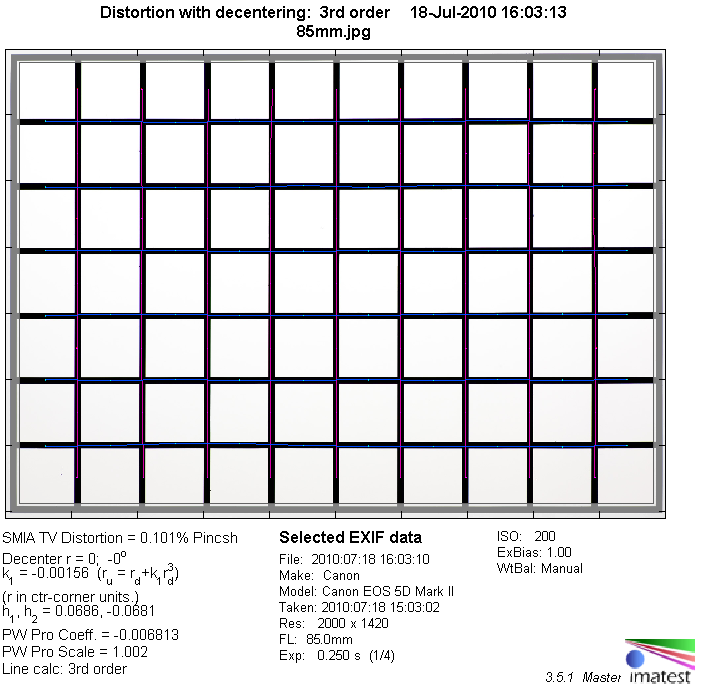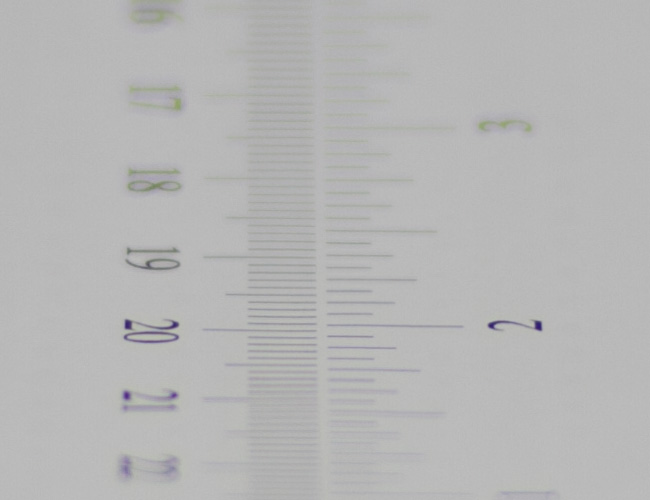|
Zeiss Planar T* 85mm f/1.4 ZF (ZE) (on Canon EOS) - Lab Test / Review - Analysis |
|
Lens Reviews -
Canon EOS (Full Format)
|
|
Page 2 of 2

Distortion
The Zeiss ZF T* 85mm f/1.4 produces an absolutely negligible degree of distortion (~0.1%).

The chart above has a real-world size of about 120x80cm.
Vignetting
The Zeiss lens exhibits the typical vignetting characteristic for an ultra-large
aperture tele lenses used on an full format DSLR. At wide-open aperture the vignetting is
high at ~1.7EV and still a bit visible at f/2. The problem is negligible from about f/2.8 onwards.

MTF (resolution)
Ultra large aperture lenses tend to struggle on full format DSLRs but the Zeiss lens
is actually a bit better than similar lenses here. The center quality is already very
good at f/1.4 and the borders/corners reach good levels (albeit just). The contrast
could be better though especially in close focus scenarios. There's a substantial
boost in quality at f/2.8 with an excellent center and very good borders/corners. The
peak performance is reached around f/5.6. The quality is about as good as it gets here.
Please note that the MTF results are not directly comparable across the different systems!
Below is a simplified summary of the formal findings. The chart shows line widths per picture height (LW/PH) which can be taken as a measure for sharpness.
If you want to know more about the MTF50 figures you may check out the corresponding Imatest Explanations
Chromatic Aberrations (CAs)
Chromatic aberrations (color shadows at harsh contrast transitions) are
relatively well controlled although we've seen better lenses in this class here.
The average CA pixel width at the image borders varies between 0.8px and 1.4px.
This may be visible upon closer observation but it's actually not really something
to worry about either.

Bokeh
The bokeh (quality of the out-of-focus blur) is generally very good. Out-of-focus highlights are very evenly rendered.
At large apertures the discs deteriorate to a "cat's eye" shape towards the image borders but
that's a rather normal behavior in this lens class. The blur is pretty smooth in the focus transition zones although
the Canon EF 85mm f/1.2 USM L II is still be a tad better here especially with respect to the foreground blur.

Bokeh Fringing / Longitudinal Chromatic Aberrations (LoCA)
The Zeiss lens shows very pronounced LoCAs at large apertures - this is, again, typical for such lenses.
These green/purple halos in the focus transition zones are very obvious at f/1.4 and f/2.
There're still some fringing hints at f/2.8 although that's not overly field relevant anymore.
You may also notice the focus shift (RSA) when stopping down from f/2 to f/2.8.
|
Move the mouse cursor over the f-stop marks below to observe the respective LoCAs
|
| f/1.4 |
f/2 |
f/2.8 |
|

|
VerdictZeiss Z-series lenses are controversial beings because they lack auto-focus. However,
Zeiss is a legendary brand name and some lenses do live up to this reputation - the
Planar T* 85mm f/1.4 does qualify here - mostly at least.
The lens is capable of producing bitingly sharp results when stopped
down a little. The vignetting characteristic is about typical for a lens in this class.
Distortions are a non-issue. The quality of the bokeh is very good although its direct
competitor, the Canon EF 85mm f/1.2 USM L II, still has an edge here.
However, there're also has a few weaknesses. The Zeiss lens shows a somewhat "dreamy"
contrast characteristic at f/1.4. Whether this is a bug or a feature is a matter of
application - portrait photographers will like it whereas still-life photographers
probably won’t. Typical for ultra-large aperture lenses there's also some degree
of purple fringing at large aperture. Due to the large front element the T* 85mm f/1.4
isn't quite as resistant against flare as its (Zeiss) cousins but certainly not worse
than comparable lenses.
The build quality is also exceptionally high and a reminiscent of times when plastics
were not the dominant form of mechanical design. The price tag of the Zeiss comes almost
as a surprise - at 1100 €/US$ it costs quite a bit less that the
Canon EF 85mm f/1.2 USM L (~1800EUR/US$) - so a deeper thought may not be as bizarre as it
seems if you're shopping in this lens class.
| Optical Quality: |
 |
|
| Field Quality: |  Portrait Photograohy) Portrait Photograohy) |
| Mechanical Quality: |  |
| Price/Performance: |  |
| | |
| | What does this mean ? |
|